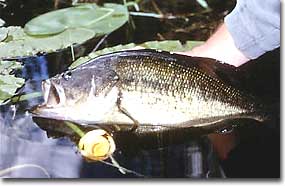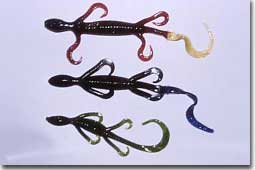Lunker Largemouth Love Lizards
Lunker Largemouth Love Lizards
By Justin Hoffman
 Plastic lizards are to bass as candy is to a child – once they grab it, they just will not let go! Once used extensively to target bedding largemouth in the United States, (where it is legal), the plastic lizard is now a staple among bassers, with numerous techniques and new adaptations having developed that make this lure stand-out as much more than a sight-fishing lure. Jump on the “lizard bandwagon” this season, and watch your success rate soar by using this phenomenal bait.
Plastic lizards are to bass as candy is to a child – once they grab it, they just will not let go! Once used extensively to target bedding largemouth in the United States, (where it is legal), the plastic lizard is now a staple among bassers, with numerous techniques and new adaptations having developed that make this lure stand-out as much more than a sight-fishing lure. Jump on the “lizard bandwagon” this season, and watch your success rate soar by using this phenomenal bait.
Types to Choose
There are many varieties of lizards on the market, each possessing different qualities and characteristics that make them a good largemouth lure. To narrow down the search, choose a lizard that is between four and six-inches in length. The warmer the water, the larger the lizard that should be fished. Make sure the plastic body is soft and supple in texture. This will ensure that the bass will not reject your offering and will hold on longer during pick-ups. Built-in scent is also valuable in this regard, as it will mask the angler’s smell and act as an attractant. I have had tremendous success using lizards with salt added. The last quality to look for in a lizard is color. It is best to choose a selection of baits in different colours that can be used under various conditions. Natural colours are your best bet in clear water and when fishing shallow, whereas bright colours are more effective in murky water or while fishing deep.
A number of baits that have been productive for me over the years are the Berkley Power Lizards, Culprit Lizards and the Kalin Lizards.
Techniques and Tactics Weightless Rigging
This technique is relatively new on the scene but is a phenomenal presentation for catching shallow-water bass. To fish this method all it takes is a lizard, a wide-gap hook and a spinning outfit. Depending on the cover you are faced with, the bait can be rigged either weedless or exposed. The spinning outfit enables the light bait to be cast accurately. Couple this with the light line and you have a very life-like and convincing presentation.
The key to fishing this bait is casting right up to shore (or even up on shore and slivering it to the waters edge), then slowly jerk it back to the boat just under the surface of the water, momentarily pausing the bait to let it flutter down beside prime cover. Similar to the plastic jerkbait, the lizard excels due to its improved action and vibration, and the more bulkier and natural appearance.
Fish this bait alongside logs, stumps and pads and be prepared to hang on, as largemouth strike this bait with reckless abandon.
Flipping and Pitching
When the plastic lizard first came on the scene, anglers were relying on flipping jigs and plastic worms to fish heavy cover and docks. Anglers in the know nowadays are turning their attention towards the lizard to up the odds in their favour.
 Plastic lizards bring a new dimension to flipping and pitching that has shown promising results for me in both tournament angling and pleasure fishing. The one major attribute the lizard has over the baits in the past is that it is fresh and new. The majority of bass have never seen a lizard dropped down beside them, and this will trigger a positive strike impulse. Unfortunately, due to the heavy fishing pressure bass receive, they become conditioned to certain lures and will display signs of lockjaw when those lures are offered repeatedly. This is why the “new” lizard really shines.
Plastic lizards bring a new dimension to flipping and pitching that has shown promising results for me in both tournament angling and pleasure fishing. The one major attribute the lizard has over the baits in the past is that it is fresh and new. The majority of bass have never seen a lizard dropped down beside them, and this will trigger a positive strike impulse. Unfortunately, due to the heavy fishing pressure bass receive, they become conditioned to certain lures and will display signs of lockjaw when those lures are offered repeatedly. This is why the “new” lizard really shines.
Another positive aspect of flipping and pitching a lizard is the extra vibrations and action the jiggling legs and tail give off. It looks more realistic than a plastic worm or jig, and it is recognizable to the largemouth as it is an actual prey species that they meet in the underwater world.
A key step I take whenever fishing lizards around heavy cover is the addition of a rattle directly into the body of the bait. These can be picked up at your local tackle store and usually consist of a small cylinder made of plastic or metal with B.B.’s inside. This extra noise source will help the largemouth key in on your bait, and will give you an added advantage when fish are hard to come by.
Hints and Tips
Even though I only purchase lizards that have impregnated scent, I also choose to put a dozen or so baits in a zip lock bag and soak them in a commercial scent overnight before a fishing trip. This lets the plastic absorb more of the taste and smell, and results in increased bites while out on the water.
There are many varieties of hooks on the market, but your best bet is to choose one in a wide-gap model from a reputable manufacture. Excalibur and Owner hooks are the two varieties I use due in part to the needle sharp point and extra penetration power. Beside these two things, both these hooks are “tested tough.”
Experiment with body styles and colours of lizards while fishing different structure. You may find that a slimmer version is better for cattails and reeds, while a bulkier type works better for docks. Each day should be spent trying to learn something new that can improve your angling
Try your luck with lizards this season and bring a new dimension to your bassin’ repertoire. They may look similar to the old plastic worm, but I can bet you that they will definitely out fish them.
|
